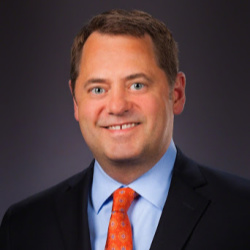
Earlier this year, ADP TotalSource enhanced to help small businesses better navigate an employment world characterized by a tight labor market, more regulations and an increasing focus on workplace culture. We spoke with ADP TotalSource Senior Vice President Brian Michaud to learn about the thinking behind its enhancements.
ADP says it recognizes that its offerings must constantly evolve to address the changing world of work. Can you expand on that?
I think everybody’s talking about the talent war, the talent shortage, how important it is to engage people and hold on to people. You know, 50 percent of employers are saying it’s tough to find the right hire. So that was in part the impetus.
The other part was looking at how we can provide more value to our clients in this area. So we did a study, mainly with our client’s employees, and found that there were four core human truths, so to speak, that are important to engage people at work: Making sure people are productive, that they have a sense of belonging, they feel inspired, and are uniquely valued.
What we’ve done is wind up all of our services through ADP TotalSource in order to help and consult with clients so they can engage their talent and keep the talent for the long term.
.@ADP TotalSource says PEO offerings must constantly evolve to address the changing world of work. Senior Vice President Brian Michaud explains why. #HR #HRTech #SmallBusiness Share on XIt seems like many of TotalSource’s offerings are strategic, not just the typical PEO nuts-and-bolts. Is that fair?

Yes, I think it is. What we’re trying to do is not just cover the basics here, but to ensure that we’re meeting our customers with what they want. I’m sure you’ve heard it: Customers want outcomes, not services. So that’s where that first type of work that I talked about comes into play. It’s about reducing turnover and getting more productivity out of people.
The other piece is really more about data. I’m going to use the term “big data,” but it’s really very pointed small data and making sure we serve it up at the right time, whether it’s around turnover or decision-making on how to pay someone or what type of benefits you need to offer.
And we can do this from a geographic standpoint or we can do it from an industry standpoint. So if we can sit down with a business owner and pick a city, we can tell them what everybody else there is paying for the same job.
I think our clients really, really value that. They don’t have time to sift through that type of information or get it someplace else. It’s the same type of thing with overtime and controlling costs. We serve it up to the manager at the right time in order for them to take an action.
Business owners and their managers don’t seem to think strategically very often, especially when it comes to HR. Were you pulled in this direction by demand, or are you trying to lead businesses, especially small businesses, in a new direction?
That’s a good question. They’re just running from one fire to another. I think a typical business owner just hopes to concentrate on their passion and make a profit as much as possible.
The first piece that I talked about—the consulting around talent in productivity, belonging, inspiration and being uniquely valued—more than 50 percent of our small businesses are engaging there. They find it valuable mainly because they’re having a talent problem. Many business owners really care about their employees despite the talk of “my boss is a jerk” or “the company doesn’t care about me.” That’s not really the truth. This is what that work is about and why over 50 percent of our customers are engaging there.
I think the other piece, the data, just makes sense. Everybody wants better information when they’re making decisions. They don’t want to shoot from the hip. If we have data and we show it to people, which we do regularly, then they’e consuming it and utilizing it in decision-making.
The changes you made earlier this year seem like an expansion or an enhancement to TotalSource’s offering as opposed to a big course change. Assuming that I’m right, what competitive advantage do they bring you?
For sure, this isn’t a course correction. They’re enhancements, so you’re right. Obviously, the space is rife with competitors. Every year we continue to win our share in the market, but it’s really about differentiating ourselves and being on that continued growth path.
What we think we have is great technology with an intersection of really great service. Part of service is delivering these things on a regular basis so that clients know we have them in mind and that we’re being proactive. So it’s really more market differentiation than anything else, especially as the PEO landscape continues to get a little bit smaller with all the consolidations in the industry.
What do you think that your clients are most interested in, the service or the technology? I’m thinking about TriNet, which seems to put an awful lot of emphasis on technology in their PEO. ADP doesn’t take the same tack, at least in terms of your marketing message.
I think clients expect both. While we don’t specifically market technology, we do have extremely strong technology, which I would put up against any other PEO’s, head-to-head, any time. It’s just not our marketing message because rather than going after the buyer on a tech message, we’re going after them on what we think we can do from the standpoint of outcomes. What can we help your business do better? Can we help you be more profitable? Can we help you engage your people longer-term? Can we help you make better decisions? Can we improve employee engagement? Can we decrease turnover?
ADP’s talked about its patent-pending approach to helping businesses select the right benefits plans. What’s so great about it that’s worth a patent?
Have you seen benefits summaries before? They’re complicated. People don’t understand the data. You can get lost in a world of… call it jargon, more than anything else.
So what we do is lay everything out in a very organized way, where clients can actually change their options or our people can help them change their options. Then it includes benchmarking, as well. If you’re the business owner and you’ve got to shave costs, you want to see if your benefits are actually going to be competitive with the people that are in your market. Otherwise you might end up losing people. That, in a sense, is what the technology is about.
On the backend, although this is not-patent pending, when the client selects a plan, we go in and help them with the enrollment and in educating employees. We do that via video or they can talk to a live person. “Here’s my situation. How do I involve benefits? What are the things that I need to consider?” So there’s support there. That’s not really part of the tool, but it’s a pretty comprehensive way to go about it.
One other thing you’ve been focusing on is helping companies with their internal brand. I haven’t heard many PEOs talk about getting involved in that before.
We think that the internal brand is so important. A great amount of power has really shifted to people, in the sense of when they’ve got full employment, they have a lot of choices of where they can go. I see so much around inclusion and pay equity, for example. And as a small business owner, you’re probably not even thinking about that. But if all of a sudden you hit the newspaper and you have issues that involve government or claims, pretty quickly people aren’t going to want to work for you.
What made you decide to invest yourselves more in this aspect of HR?
It’s really this function of what’s happening in the market and how hard it is to get and retain talent. That’s why we’re spending a lot of time on it right now.
And probably the reason why we have so many clients interested in this work is because the issue resonates with them and they feel a need. I always like to talk to small business owners. I’m glad you were one. I’m sure you remember that it’s a hailstorm of stuff all day long. You’re not even thinking about HR as a small business owner. You’re thinking about making your widgets or serving your customers or figuring out how you can get a greater share of wallet or whatever. You might even be thinking about how to leave a legacy for someone. But you’re definitely not thinking about HR every day and it’s a pretty hairy role with all the compliance that’s out there, for sure.
Any other thoughts?
think the only thing that I didn’t mention, when I talked about us delivering these services, is that they’re being delivered by a dedicated team of credentialed HR experts. The people that are out there doing this stuff, they’ve been doing it most of their career.
One of the things that’s really unique about a PEO, and I’m sure this holds true for other PEOs as well, is that when you have an HR person who deals with a myriad of different companies, they bring all that experience with them. It’s very hard for them to see something new. All their experience isn’t with just one company, and I think that’s really valuable as well.
Sign up for our newsletter here.
Image: iStock














